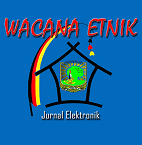Struktur Fonologis Nama Orang Minangkabau
Abstract
Name of the Minangkabaunese has its own characteristics which can be recognized through the phonological structure. This article describes the number of word length Minangkabau name, the number of syllables, and the nature of each syllable of the name. There are three methods and research techniques used in this study: providing data, data analysis, and presentation of analysis results.
Based on the number, the phonological structures of the Minangkabaunese names have two tendencies. First, people over 43 years old tend to consist of 1 (one) word name. In contrast, less than 44 years old tend to consist of two words name. Based on the number of syllables, the Minangkabaunese names also have two tendencies. First, over 43 years old the name tends to consist of three (3) syllables followed by a name consisting of 2 (two) syllables. The name of the Minangkabau people under 44 years are more varied, there consist of 2 to 5 syllables, some of them consisting of 6 to 7 syllables. Furthermore, the long name is not found Minangkabau consisting of one syllable and exceeds 7 syllables. Finally, based on the nature, there are two properties of syllables in the Minangkabaunese name which are closed syllables and open syllables.
Keywords
Full Text:
PDFReferences
Almos, Rona. 2010. “Makna Nama Diri pada Masyarakat Minangkabau”. Laporan Penelitian Dana DIPA Unand tahun 2010.
Baikoeni, Elfitra. 2009.“Nama Orang Minangkabau: Unik, Fleksibel, dan “Aneh”. www.scribd.com/doc/, 10 Mei 2009.
Bright, William. 1971. Sosiolinguistic. Paris: The Hague.
Catford, J.C. 1990. A Practical Introduction to Phonetics. New York: Oxford University Press.
Crystal, David. 1987. The Cambridge Encyclopedia of Languge. Cambridge: Cambridge University Press.
Fasold, Ralph. 1990. The Sociolinguistic of Language. Cambridge Centre: Basil Block Well Inc
file///D:/pendidikkan/berkarakter.htm. “Pendidikan di Indonesia Belum Berhasil”.
file///D:/ahmad-farhan/hamid/pembangunan/karakter/dimulai/dari/keluarga.htm. “Pembangun Karakter Dimulai dari Keluarga”
guario.blogspot.com/2004/10. “Kalau Orang Minang Kasih Nama”. 10 Mei 2009.
Koentjaraningrat. 1990. Beberapa Pokok Antropologi Sosial. Jakarta: Dian Rakyat.
Kridalaksana, Harimurti. 1993. Kamus Linguistik. Cet. III. Jakarta : Gramedia
_______.1989. Pembentukan Kata Dalam Bahasa Indonesia. Jakarta: Gramedia.
_______.1986. Kelas Kata dalam Bahasa Indonesia. Jakarta : Gramedia.
Lapoliwa, Hans. 1981. ‘A Generative Approach to the Phonology of Bahasa Indonesia”.
Canberra: Pacific Linguistics.
_______.1982. “Phonological Problem of Loanwords in Bahasa Indonesia”. Canberra: Pacific
Linguistics. C-75.
Mahsum, 2005. Metode Penelitian Bahasa : Tahapan Strategis Metode dan Tekniknya. Jakarta : PT. Raja Grafindo Persada.
Marnita, Rina. 2000. “Perubahan Sosial Budaya dan Dampaknya terhadap Bahasa Minangkabau”. Makalah yang dipresentasikan pada Seminar Linguistik Bahasa dan Perubahan Sosial yang Diselenggarakan oleh MLI Cabang Unand. Padang, Mei 11.
Moussay, Gerard. 1981. La Langue Minangkabau. Association Archipel.
Navis, A.A. 1985. Alam Terkambang Jadi Guru. Jakarta: PT Grafiti Pers.
Noviatri. 1997. “Kaidah Fonotaktik Nama-nama Daerah di Jawa” . Laporan Peneltian Mandiri.
Pusat Pembinaan dan Pengembangan Bahasa. 1993. Tata Bahasa Minangkabau.Jakarta.
Reniwati. 2008. “StrukturFonologis Nama Orang Minangkabau”. Laporan Penelitian DIPA Unand.
Sudaryanto, 1993. Metode dan Teknik Analisisi Bahasa, Yogyakarta : Duta Wacana. University Press.
_______,.1994. Pemanfaatan Potensi Bahasa. Yogyakarta : Gadjah Mada University Press.
Thomas dan Wareing. 2007. Bahasa, Masyarakat & Kekuasaan (terjemahan). Yogyakarta:
Pustaka Pelajar.
Yusuf, Suhendra, Drs., M.A. 1998. Fonetik dan Fonologi. Jakarta: PT Gramedia Pustaka Utama.
DOI: http://dx.doi.org/10.25077/we.v4.i2.52
Refbacks
- There are currently no refbacks.
REPOSITORI / TERINDEKS DALAM
STATISTIK PENGUNJUNG














